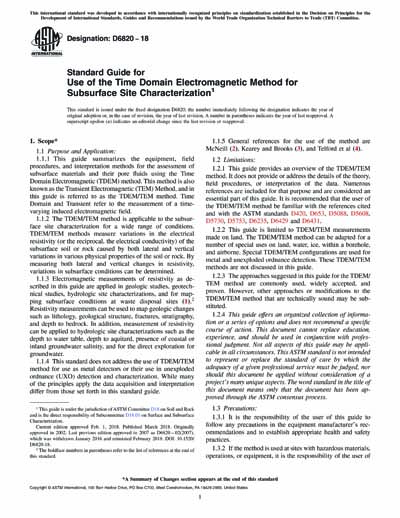Historical
ASTM D6820-18
Standard Guide for Use of the Time Domain Electromagnetic Method for Subsurface Site Characterization
1.1 Purpose and Application:
1.1.1 This guide summarizes the equipment, field procedures, and interpretation methods for the assessment of subsurface materials and their pore fluids using the Time Domain Electromagnetic (TDEM) method. This method is also known as the Transient Electromagnetic (TEM) Method, and in this guide is referred to as the TDEM/TEM method. Time Domain and Transient refer to the measurement of a time-varying induced electromagnetic field.
1.1.2 The TDEM/TEM method is applicable to the subsurface site characterization for a wide range of conditions. TDEM/TEM methods measure variations in the electrical resistivity (or the reciprocal, the electrical conductivity) of the subsurface soil or rock caused by both lateral and vertical variations in various physical properties of the soil or rock. By measuring both lateral and vertical changes in resistivity, variations in subsurface conditions can be determined.
1.1.3 Electromagnetic measurements of resistivity as described in this guide are applied in geologic studies, geotechnical studies, hydrologic site characterizations, and for mapping subsurface conditions at waste disposal sites (1).2 Resistivity measurements can be used to map geologic changes such as lithology, geological structure, fractures, stratigraphy, and depth to bedrock. In addition, measurement of resistivity can be applied to hydrologic site characterizations such as the depth to water table, depth to aquitard, presence of coastal or inland groundwater salinity, and for the direct exploration for groundwater.
1.1.4 This standard does not address the use of TDEM/TEM method for use as metal detectors or their use in unexploded ordnance (UXO) detection and characterization. While many of the principles apply the data acquisition and interpretation differ from those set forth in this standard guide.
1.1.5 General references for the use of the method are McNeill (2), Kearey and Brooks (3), and Telford et al (4).
1.2 Limitations:
1.2.1 This guide provides an overview of the TDEM/TEM method. It does not provide or address the details of the theory, field procedures, or interpretation of the data. Numerous references are included for that purpose and are considered an essential part of this guide. It is recommended that the user of the TDEM/TEM method be familiar with the references cited and with the ASTM standards D420, D653, D5088, D5608, D5730, D5753, D6235, D6429 and D6431.
1.2.2 This guide is limited to TDEM/TEM measurements made on land. The TDEM/TEM method can be adapted for a number of special uses on land, water, ice, within a borehole, and airborne. Special TDEM/TEM configurations are used for metal and unexploded ordnance detection. These TDEM/TEM methods are not discussed in this guide.
1.2.3 The approaches suggested in this guide for the TDEM/TEM method are commonly used, widely accepted, and proven. However, other approaches or modifications to the TDEM/TEM method that are technically sound may be substituted.
1.2.4 This guide offers an organized collection of information or a series of options and does not recommend a specific course of action. This document cannot replace education, experience, and should be used in conjunction with professional judgment. Not all aspects of this guide may be applicable in all circumstances. This ASTM standard is not intended to represent or replace the standard of care by which the adequacy of a given professional service must be judged, nor should this document be applied without consideration of a project's many unique aspects. The word standard in the title of this document means only that the document has been approved through the ASTM consensus process.
1.3 Precautions:
1.3.1 It is the responsibility of the user of this guide to follow any precautions in the equipment manufacturer's recommendations and to establish appropriate health and safety practices.
1.3.2 If the method is used at sites with hazardous materials, operations, or equipment, it is the responsibility of the user of this guide to establish appropriate safety and health practices and to determine the applicability of any regulations prior to use.
1.3.3 This guide does not purport to address all of the safety concerns that may be associated with the use of the TDEM/TEM method. It must be emphasized that potentially lethal voltages exist at the output terminals of many TDEM/TEM transmitters, and also across the transmitter loop, which is sometimes uninsulated. It is the responsibility of the user of this equipment to assess potential environmental safety hazards resulting from the use of the selected equipment, establish appropriate safety practices and to determine the applicability of regulations prior to use.
1.3.4 Units—The values stated in SI units are regarded as standard. No other units of measurement are included in this standard. Reporting of test results in units other than SI shall not be regarded as nonconformance with this guide.
1.4 This international standard was developed in accordance with internationally recognized principles on standardization established in the Decision on Principles for the Development of International Standards, Guides and Recommendations issued by the World Trade Organization Technical Barriers to Trade (TBT) Committee.
Content Provider
ASTM International [astm]






